Python's popularity continues to rise thanks to its simplicity, readability, and the vast ecosystem of libraries that extend its capabilities. Whether you are into data science, web development, automation, or machine learning, Python has a library that can simplify your work. Here, we'll explore some of the most used Python libraries that every developer should be familiar with, along with why they are so widely adopted.
1. NumPy
NumPy is a fundamental package for numerical computing in Python. It provides support for arrays, matrices, and a vast collection of mathematical functions to operate on these data structures. With NumPy, operations on large datasets become faster and more efficient, making it indispensable for tasks involving numerical calculations. Here's an example of creating a NumPy array:
import numpy as np
# Creating a 1D array
array = np.array([1, 2, 3, 4, 5])
print(array)2. Pandas
Pandas is essential for data manipulation and analysis. It introduces data structures like DataFrames and Series that are perfect for handling and analyzing structured data. Data scientists and analysts rely on Pandas for its ability to transform raw data into actionable insights with minimal code. Here's a basic example of creating a DataFrame:
import pandas as pd
# Creating a DataFrame
data = {'Name': ['Alice', 'Bob', 'Charlie'], 'Age': [25, 30, 35]}
df = pd.DataFrame(data)
print(df)3. Matplotlib
Matplotlib is the cornerstone of data visualization in Python. It allows developers to create a wide range of static, interactive, and animated plots. Here's an example of a simple line plot:
import matplotlib.pyplot as plt
# Simple line plot
x = [1, 2, 3, 4]
y = [10, 20, 25, 30]
plt.plot(x, y)
plt.title('Simple Line Plot')
plt.xlabel('X-axis')
plt.ylabel('Y-axis')
plt.show()4. Scikit-Learn
Scikit-learn is a robust library that provides a simple and efficient suite of tools for data mining, machine learning, and data analysis. Here's an example of using Scikit-learn for linear regression:
from sklearn.linear_model import LinearRegression
# Sample data
X = [[1], [2], [3], [4]]
y = [3, 6, 9, 12]
# Creating and fitting the model
model = LinearRegression()
model.fit(X, y)
# Predicting
prediction = model.predict([[5]])
print(prediction)5. TensorFlow and PyTorch
TensorFlow and PyTorch are two of the most popular libraries for deep learning. TensorFlow, developed by Google, offers flexibility and scalability, while PyTorch, developed by Facebook, is known for its ease of use. Here's a simple PyTorch example:
import torch
# Simple tensor operation
x = torch.tensor([1.0, 2.0, 3.0])
y = torch.tensor([4.0, 5.0, 6.0])
z = x + y
print(z)6. Requests
Requests is a simple yet powerful library for making HTTP requests in Python. Here's an example of sending a GET request:
import requests
# Sending a GET request
response = requests.get('https://api.github.com')
print(response.status_code)
print(response.json())7. Flask and Django
Flask and Django are two of the leading web development frameworks in Python. Flask is a micro-framework that's lightweight and easy to set up, while Django provides a full suite of features for building scalable web applications. Here's a simple Flask app:
from flask import Flask
app = Flask(__name__)
@app.route('/')
def home():
return "Hello, Flask!"
if __name__ == '__main__':
app.run(debug=True)8. Beautiful Soup and Scrapy
For web scraping, Beautiful Soup and Scrapy are the go-to libraries. Beautiful Soup is perfect for small-scale scraping tasks. Here's a basic example of parsing HTML with Beautiful Soup:
from bs4 import BeautifulSoup
html = "Test Hello, world!
"
soup = BeautifulSoup(html, 'html.parser')
# Extracting the title
print(soup.title.text)9. SQLAlchemy
SQLAlchemy provides a powerful and flexible ORM system for database interactions in Python. Here's an example of defining a model with SQLAlchemy:
from sqlalchemy import create_engine, Column, Integer, String, Base
# Creating an SQLite database
engine = create_engine('sqlite:///example.db')
Base = declarative_base()
# Defining a model
class User(Base):
__tablename__ = 'users'
id = Column(Integer, primary_key=True)
name = Column(String)
# Creating the table
Base.metadata.create_all(engine)10. OpenCV
OpenCV is an open-source library for computer vision tasks, including real-time image processing. Here's a basic example of reading and displaying an image using OpenCV:
import cv2
# Reading an image
img = cv2.imread('image.jpg')
# Displaying the image
cv2.imshow('Image', img)
cv2.waitKey(0)
cv2.destroyAllWindows()Conclusion
These Python libraries are just a glimpse into the rich ecosystem that makes Python so versatile and powerful. By mastering these tools, developers can tackle a wide variety of challenges, from simple data manipulations to complex machine learning algorithms. Whether you're a novice or an experienced developer, familiarizing yourself with these essential libraries will significantly enhance your Python programming skills and broaden your project capabilities.
